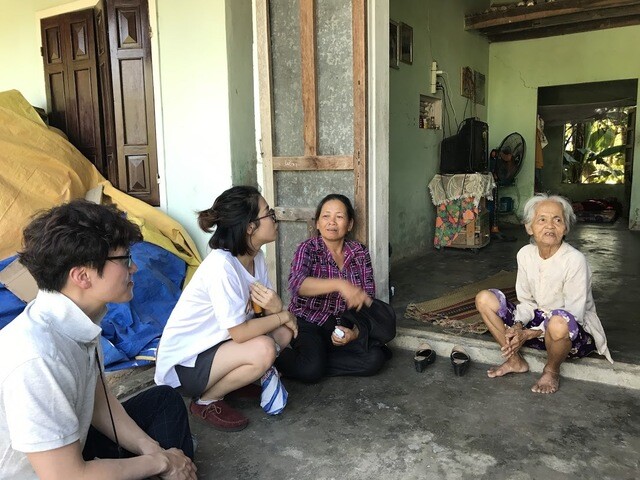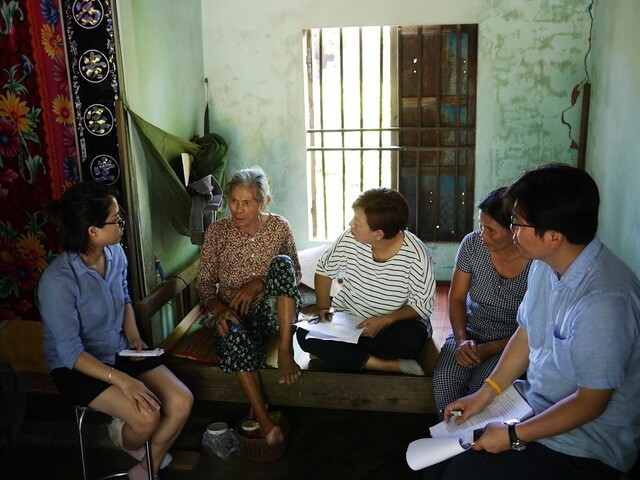hankyoreh
Links to other country sites 다른 나라 사이트 링크
First citizens’ tribunal coming from Vietnam War victims of South Korean soldiers

Nguyen Thi Thanh recalls memories from over 50 years ago as she answered questions from South Korean attorneys in the conference room of a hotel in Da Nang, Vietnam, on the morning of June 3. She was asked, “After killing your aunt, did [the South Korean troops] all leave the village together?”, and said, “They stabbed my aunt, set fire to the body and burned the house down, and then they immediately left the village. My brother and I just managed to escape to a neighbor’s house. He crawled and I walked.”
On a piece of white paper, the 57-year-old drew a diagram of the dugout where she had hidden from the South Korean troops. During her detailed account of the events, Nguyen sometimes lowered her head and sighed softly, as though she had trouble continuing. Continuing her testimony for more than three hours, she was asked toward the end of the interview how she felt when she saw South Korean veterans of the Vietnam War denying the incident took place.
“I thought we’d hear an apology from the soldiers,” a tearful Nguyen replied. “There were a lot of questions I wanted to ask when we got an apology - why they shot my family members when they were just young children. But I never even got that chance.”
Six attorneys with a MINBYUN-Lawyers for a Democratic Society task force to investigate massacres of civilians by South Korean troops during the Vietnam War visited the sites of the killings on June 2 to 7 to conduct an investigation. It was the first group investigation by attorneys from South Korea - the side responsible for the massacres - since the civilian massacre issue first surfaced as a public issue with the Hankyoreh 21’s initial reporting in 1999. MINBYUN, which is currently preparing a lawsuit by Vietnamese victims demanding compensation from the South Korean state for its role in the massacres, has been planning a “citizens’ tribunal” as a form of mock litigation ahead of the actual legal battle. The aim is to use the tribunal to show the government’s responsibility and generate momentum going into the lawsuit.
In their visits to the villages of Phong Nhi, Phong Nhat, and Ha My in Quang Nam Province, where the majority of massacres by South Korean troops took place during the Vietnam War, the MINBYUN attorneys focused on gathering the specific survivor accounts and data they would need for the suit.

On June 3, the attorneys visited Nguyen, a survivor of the Phong Nhi-Phong Nhat massacre. Located 25 km south of Da Nang, the two villages were the scene of the massacre of 74 people - including elderly people, children, and women - by the 1st Company of the Blue Dragon Unit’s 1st Battalion on Feb. 12, 1968. Nguyen, who was eight at the time, lost five family members in the massacre, including her aunt, older sister, and younger brother.
“I was hiding in a dugout when the South Korean troops arrived in the village. As the children came out of the dugouts, the soldiers stood them up in the yard and shot them one by one,” she recalled.
To ensure the credibility of Nguyen’s account, the attorney focused their questions on areas from her previous testimony that needed to be expanded upon. Detailed testimony from survivors is essential if the crime - in this case, the massacre by South Korean troops - is to be proven in an actual court.
“She was lying there without losing consciousness, and she was bleeding heavily,” recalled Nguyen Thi Luong, now 78, who accompanied the wounded Nguyen Thi Thanh as she was taken to the hospital by helicopter.
On June 4 and 5, the attorneys visited Ha My to hear accounts from four survivors there, including 72-year-old Nguyen Cay, who lost five family members in the massacre. Ha My was the site of a massacre of civilians by the Blue Dragons (2nd Marine Division) on Feb. 22, 1968.
“For the Phong Nhi-Phong Nhat massacre, we had a fair amount of evidence already and focused on fleshing out the testimony we had, but the Ha My massacre hadn’t been adequately investigated, and we focused on getting primary testimony,” explained Im Jae-seong, an attorney on the task force.
“Since our ultimate goal here is filing suit for damages from the state, our aim is to gather enough testimony and evidence for a South Korean court to acknowledge the massacres took place,” Im explained.

After putting together a citizens’ tribunal preparation committee around this coming July, the MINBYUN task force and Korea-Vietnam Peace Foundation plan to hold the actual tribunal process around Apr. 2018, which marks the 43rd anniversary of the Vietnam War’s end. The tribunal is to take place in Seoul or Jeju with victims of civilian massacres in Vietnam as plaintiffs. The idea was inspired by the Women's International War Crimes Tribunal held in Tokyo in Dec. 2000 to assign responsibility for Japan’s drafting of comfort women into sexual slavery during World War II.
“Over the 18 years since the first reports [on massacres by South Korean troops], the South Korean government hasn’t made any efforts on the victims’ behalf,” Lim said.
“If even one person is recognized through the lawsuit as having been victimized, the government will have no choice but to take responsible action,” he predicted.
By Hwang Keum-bi, staff reporter
Please direct questions or comments to [english@hani.co.kr]

Editorial・opinion
![[Column] Season 2 of special prosecutor probe may be coming to Korea soon [Column] Season 2 of special prosecutor probe may be coming to Korea soon](https://flexible.img.hani.co.kr/flexible/normal/500/300/imgdb/original/2024/0426/3317141030699447.jpg) [Column] Season 2 of special prosecutor probe may be coming to Korea soon
[Column] Season 2 of special prosecutor probe may be coming to Korea soon![[Column] Park Geun-hye déjà vu in Yoon Suk-yeol [Column] Park Geun-hye déjà vu in Yoon Suk-yeol](https://flexible.img.hani.co.kr/flexible/normal/500/300/imgdb/original/2024/0424/651713945113788.jpg) [Column] Park Geun-hye déjà vu in Yoon Suk-yeol
[Column] Park Geun-hye déjà vu in Yoon Suk-yeol- [Editorial] New weight of N. Korea’s nuclear threats makes dialogue all the more urgent
- [Guest essay] The real reason Korea’s new right wants to dub Rhee a founding father
- [Column] ‘Choson’: Is it time we start referring to N. Korea in its own terms?
- [Editorial] Japan’s rewriting of history with Korea has gone too far
- [Column] The president’s questionable capacity for dialogue
- [Column] Are chaebol firms just pizza pies for families to divvy up as they please?
- [Column] Has Korea, too, crossed the Rubicon on China?
- [Correspondent’s column] In Japan’s alliance with US, echoes of its past alliances with UK
Most viewed articles
- 1Samsung subcontractor worker commits suicide from work stress
- 2‘We must say no’: Seoul defense chief on Korean, USFK involvement in hypothetical Taiwan crisis
- 3Is Japan about to snatch control of Line messenger from Korea’s Naver?
- 4Division commander ordered troops to enter raging flood waters before Marine died, survivor says
- 5[Editorial] Korea’s surprise Q1 growth requires objective assessment, not blind fanfare
- 6No good, very bad game for Korea puts it out of Olympics for first time since 1988
- 7US overtakes China as Korea’s top export market, prompting trade sanction jitters
- 8Korea’s 1.3% growth in Q1 signals ‘textbook’ return to growth, says government
- 9N. Korean delegation’s trip to Iran shows how Pyongyang is leveraging ties with Moscow
- 10[Column] Season 2 of special prosecutor probe may be coming to Korea soon